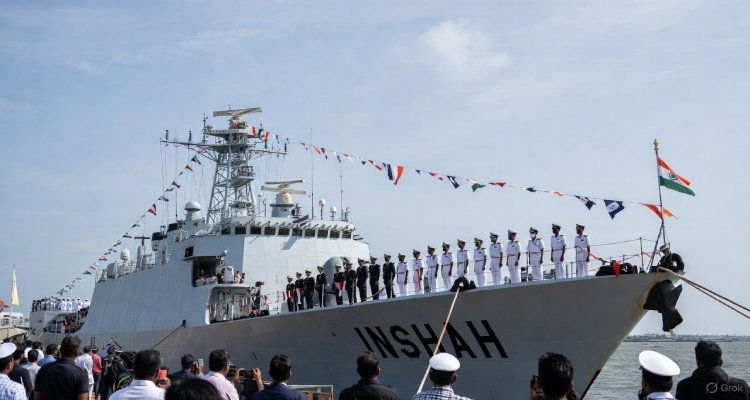DRDO Develops New Generation of Man-Portable Autonomous Underwater Vehicles
DRDO’s Naval Science & Technological Laboratory has developed next-generation Man-Portable Autonomous Underwater Vehicles (MP-AUVs) using AI-driven target recognition and underwater communication systems for mine countermeasure missions.
Introduction: A Leap Beneath the Waves
In a significant stride for India’s undersea defense capabilities, the Defence Research and Development Organisation (DRDO) has unveiled a new generation of Man-Portable Autonomous Underwater Vehicles (MP-AUVs). Developed by the Naval Science & Technological Laboratory (NSTL) in Visakhapatnam, these compact yet powerful systems are designed to detect, classify, and neutralize underwater mines with minimal human intervention. This advancement represents a major leap in the Navy’s quest to ensure safe and efficient operations in the country’s maritime zones.
Context and Background
Underwater mine warfare remains one of the most complex and hazardous aspects of naval defense. Traditional mine countermeasure operations rely heavily on human divers and remotely operated vehicles, exposing personnel to significant risks and logistical challenges. Recognizing this need for modernization, DRDO’s NSTL initiated a project to create a fully autonomous, portable underwater platform capable of operating in littoral zones and confined maritime environments.
NSTL, one of DRDO’s premier laboratories dedicated to naval system development, has decades of experience in torpedo systems, underwater sensors, and autonomous navigation technology. The laboratory’s continued research has positioned India among the handful of nations capable of producing next-generation Autonomous Underwater Vehicles (AUVs) tailored for military and research purposes.
Main Developments: Smart AUVs Revolutionize Mine Warfare
The newly developed MP-AUVs represent a culmination of advanced underwater engineering, artificial intelligence, and communication systems. Each AUV is equipped with side-scan sonar and high-resolution underwater cameras, enabling precise mapping and identification of mine-like objects in real time.
A standout feature of these platforms is the integration of deep learning-based target recognition algorithms. This artificial intelligence capability allows the vehicles to autonomously classify underwater threats without requiring constant operator input. As a result, mission duration and human workload are drastically reduced, improving overall efficiency and mission turnaround time.
Field trials conducted at the NSTL harbour recently confirmed the vehicle’s operational reliability. Critical parameters such as navigation accuracy, communication stability, image clarity, and object classification performance were successfully validated. The trials demonstrated that the AUVs could operate cooperatively within a network, communicating through robust underwater acoustic systems to share data, update mission routes, and enhance situational awareness during operations.
Expert Insight: Expanding the Navy’s Strategic Reach
Experts in the field of naval technology have lauded DRDO’s innovation as a pivotal development for India’s defense readiness. Dr. R. Natarajan, a retired naval systems analyst, commented, “Man-portable AUVs mark a new era in undersea warfare. Their autonomy and swarm coordination capabilities not only reduce risk to human divers but also exponentially increase operational efficiency during mine countermeasure missions.”
Industry insiders note that several private partners have collaborated with NSTL for system realization, including firms specialized in robotics, sonar manufacturing, and AI integration. This collaboration reflects India’s growing defense-industrial ecosystem, bridging government R&D and private enterprise to deliver cutting-edge, mission-ready systems.
Impact and Implications: Strengthening India’s Maritime Security
The MP-AUVs are expected to enter production soon, with the first operational units likely to be deployed by the Indian Navy within the coming months. Once commissioned, these systems will enhance India’s ability to secure naval bases, amphibious assault routes, and critical sea lanes of communication, particularly in regions prone to mine warfare threats.
Beyond defense, the technology holds potential for civil and scientific applications such as underwater surveying, seabed mapping, and environmental monitoring. The deep learning and autonomous navigation modules developed for military use can be adapted for oceanographic research, offshore infrastructure inspection, and disaster response missions.
Strategically, DRDO’s success in this domain underscores India’s self-reliant defense posture and commitment to indigenous manufacturing under the “Atmanirbhar Bharat” initiative. Deploying autonomous systems for underwater missions reduces dependence on imported technologies and ensures sustained deterrence in regional waters.
Conclusion: Charting the Future of Underwater Autonomy
The development of the new generation MP-AUVs marks a significant milestone for India’s defense research ecosystem. By blending artificial intelligence, robust communication networks, and compact design, DRDO’s NSTL has opened a new chapter in undersea operations. As these vehicles move from prototype to production, they promise to redefine how India conducts maritime security and underwater exploration in the coming decade.
For a nation heavily reliant on maritime trade and strategic waterways, the rise of autonomous underwater systems represents more than technological progress—it is a step toward a safer, smarter, and more resilient naval future.
Disclaimer: This article is based on verified public information, including official DRDO sources and national defense briefs. The author is a trainer for Civil Services aspirants, and the analysis reflects independent interpretation of publicly available data.










